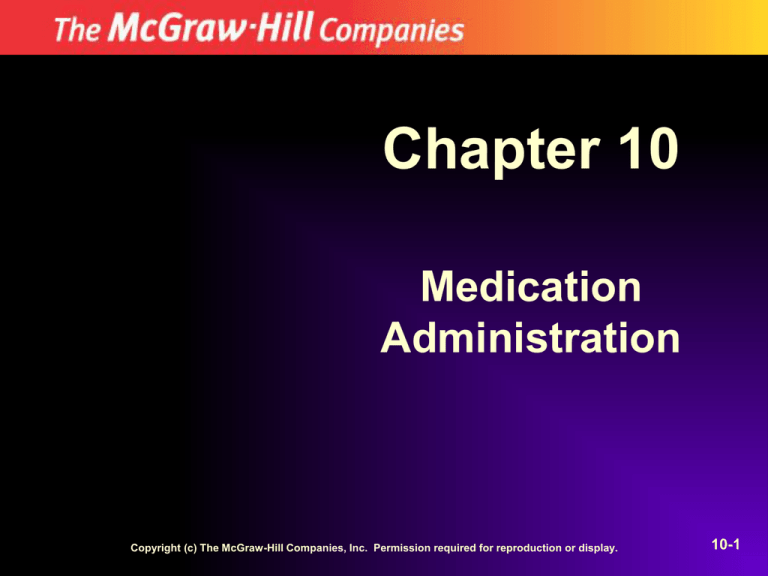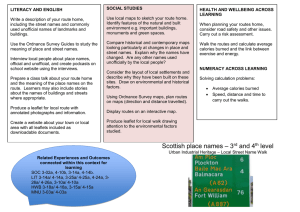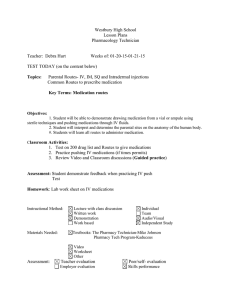Chapter 10 Medication Administration 10-1
advertisement

Chapter 10 Medication Administration Copyright (c) The McGraw-Hill Companies, Inc. Permission required for reproduction or display. 10-1 Objectives 10-2 Drug Administration 10-3 General Guidelines • An EMT can give, or assist a patient in taking, medications only by the order of a licensed physician. 10-4 General Guidelines • Assess the patient • Obtain a medication history including: – Prescribed medications (name, strength, daily dosage) – Over-the-counter medications – Allergies to medications 10-5 General Guidelines • You must be knowledgeable about each drug you give including the following: – Mechanism of action – Indications – Dose – Route of administration – Contraindications – Adverse effects – Special considerations 10-6 General Guidelines • Information to relay to medical direction: – Patient’s age – Chief complaint – Vital signs – Signs and symptoms – Allergies – Current medications – Pertinent past medical history 10-7 Physician’s Order • Order will include: – Drug name – Drug dose – Drug route • Repeat orders back to physician 10-8 The Six Rights of Drug Administration 10-9 The Six Rights of Drug Administration 1. Right patient 2. Right medication 3. Right dose 4. Right route 5. Right time (frequency) 6. Right documentation 10-10 Routes of Drug Administration 10-11 Routes of Drug Administration • Enteral • Parenteral 10-12 Enteral Routes of Drug Administration • Oral route – Requires a responsive, cooperative patient – Advantages – Disadvantages 10-13 Enteral Routes of Drug Administration • Oral route – Technique • Use appropriate personal protective equipment • The inside of the medicine container, its contents, and the inside of the container’s cap are considered clean. • Be careful not to touch these areas. 10-14 Enteral Routes of Drug Administration • Oral route – Technique • When administering a tablet: – Open the medication container – Pour the correct number of tablets into the inside cap of the container – Pour the tablets into the patient’s hand » Do not contaminate the inside cap of the container – Carefully recap the container 10-15 Enteral Routes of Drug Administration • Buccal route – “Pertaining to the cheek” – Advantages – Disadvantages – Technique 10-16 Enteral Routes of Drug Administration • Sublingual route – Drug given under the tongue – Rapid absorption – Advantages – Disadvantages – Technique 10-17 Parenteral Routes of Drug Administration • Inhalation route – Rapid onset of action – Gas (oxygen) – Mist / aerosol (albuterol) – Advantages – Disadvantages 10-18 Parenteral Routes of Drug Administration • Subcutaneous route – Needle inserted underneath the skin into the subcutaneous tissue – Advantages – Disadvantages – Technique 10-19 Parenteral Routes of Drug Administration • Intramuscular route – Medication in a liquid form is injected into a large mass of skeletal muscle – Advantages – Disadvantages – Technique 10-20 Reassessment and Documentation • After giving a drug: – Document the reason the drug was given – Document the medication administered and the time you gave it – Reassess the patient – Document the patient’s vital signs and response to the drug. 10-21 Questions? 10-22




